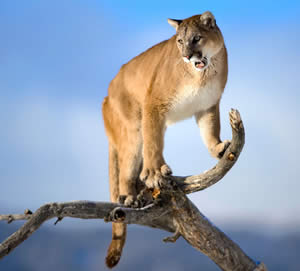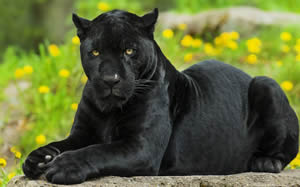Difference between Puma and Panther
Key Difference: Both Puma and Panther are members of the Felidae family. However, an underlying difference between Puma and Panther is that Puma sizes vary according to habitat, and are mainly found near mountainous areas. Whereas, Panthers are powerful, intelligent, and exotic animals, which are mainly found in Latin America, Asia and Africa.
Though Puma and Panther belong to the Animalia Kingdom and Felidae Family, they vary in their features, size, color, and many other things.
 Puma is a large wild animal. At times, it is considered similar to his cousin cat, the lion, because of its plain skin coat, as compared to other spot coated cousin cats. Puma is also commonly referred to as cougar, and is the second largest cat in North America. Puma is also known as the mountain lion, panther, mountain cat, and catamount. The puma is unbelievably flexible to its environment. A puma in the wild will not mate until it has established a home territory. On the other hand, panther’s mating season is from December through February. The young stay with their mother for about two years. Females do not mate again until the young have left.
Puma is a large wild animal. At times, it is considered similar to his cousin cat, the lion, because of its plain skin coat, as compared to other spot coated cousin cats. Puma is also commonly referred to as cougar, and is the second largest cat in North America. Puma is also known as the mountain lion, panther, mountain cat, and catamount. The puma is unbelievably flexible to its environment. A puma in the wild will not mate until it has established a home territory. On the other hand, panther’s mating season is from December through February. The young stay with their mother for about two years. Females do not mate again until the young have left.
A panther is the same as a leopard, while the term Panthera describes the whole family of big cats. Panther is most commonly assigned to the Black Panther, which is a melanistic jaguar, leopard and the Florida panther, a subspecies of cougar. Only four of the Panthera cat species have the ability to roar. Black panthers are most commonly melanistic variations of jaguars, leopards, and very rare black tigers. In Jaguars, the melanism gene is dominant and black jaguars may produce either black or spotted cubs.

Puma is most commonly found from the Canadian Yukon to the southern Andes of South America. Whereas, panthers are most commonly found in southwestern China, Myanmar, Assam and Nepal, Travancore and other parts of southern India. Unlike the big cats, puma never roars, instead it growls, hisses, screeches and purrs, whereas panther can produce roars. Puma can vary from silver gray, to tawny to reddish, whereas panther can vary from white to black.
Comparison between Puma and Panther:
|
|
Puma |
Panther |
|
Technical name |
Puma concolor |
Puma concolor |
|
Family |
Felidae |
Felidae |
|
Genus |
Puma |
Panthera |
|
Kingdom |
Animalia |
Animalia |
|
Phylum |
Chordata |
Chordata |
|
Class |
Mammalia |
Mammalia |
|
Order |
Carnivora |
Carnivora |
|
Origin of the word |
Puma comes from the Spanish word “puma” which was derived from the Quecha language of Peru. |
Panther was derived from classical Latin panthēra, itself from the ancient Greek pánthēr, meaning "large spotted cat" |
|
Cats |
Puma is the largest and the wildest cat of all the four cats. |
Panther is one among the several species of larger cats. |
|
Size |
Puma is up to 9 feet long although the average length is 6 – 8 feet. |
Panther is 5.9 to 7.5 feet long. |
|
Weight |
Weight is up to 29 to 90 kg |
Weight is up to 30 to 72 kg |
|
Habitat |
West coast of Canada, in the western half of the United States, including Alaska and Florida, and most of Central and South America |
Latin America, Asia and Africa |
|
Build |
Pumas have large muscular, short legs, and a small but long skull. |
Panthers have small heads with strong jaws and emerald green eyes, and tend to have hind legs that are both larger and slightly longer than those at the front. |
|
Vocalization |
Puma never roar, instead it can growl, hiss, screech and purr. |
The Panther is not only one of the largest felines in the world but it is also able to roar which is something that felines outside of this group are not able to do. |
|
Prey |
They are pure carnivores. They hunt deer, raccoons, squirrels, foxes, rabbits and skunks. |
They are herbivores. Animals including Deer, Warthogs, Wild Boar, Tapir and Antelope are all hunted by Panthers, along with smaller species like birds and rabbits when larger prey is scarce. |
|
Hunt |
A puma’s killing bite is applied to the back of the neck, head, or throat and inflicts puncture marks with their claws usually seen on the sides and underside of the prey, sometimes also shredding the prey as they hold on. |
They hunt under the cover of night. |
Image Courtesy: absolutetravel.com, picturebypali.deviantart.com









Add new comment